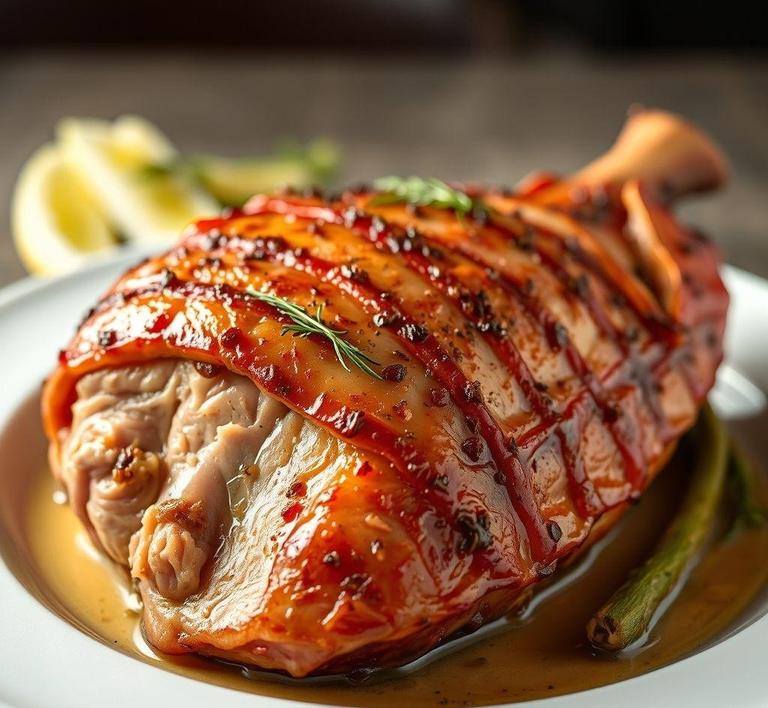If you’re like most people, you’ve probably had the dilemma of not finishing a whole cooked ham and wondering what to do with the leftovers. Can you refreeze cooked ham? The good news is, yes, you can-although it’s important to know the right way to do it to ensure the quality stays top-notch. Refreezing cooked ham can save you from wasting food, but it’s crucial to follow a few key steps to avoid texture changes or potential health risks. This guide will walk you through the best practices for refreezing cooked ham, from how to store it properly to how long it can be kept, so you can enjoy it again without losing any flavor!
Can You Refreeze Cooked Ham?

Refreezing cooked ham is a common question when it comes to food storage and preservation. Whether you’ve cooked a large ham for a holiday dinner or have leftovers from a deli-sized portion, the idea of freezing it for later use can seem like a convenient solution. But can you refreeze cooked ham, and is it safe?
The short answer is yes, you can refreeze cooked ham, but there are several important factors to consider. The key concern lies in the conditions under which the ham was initially frozen, thawed, and the way it’s been handled since. Freezing and thawing meat multiple times can lead to changes in both its safety and quality. If done properly, refreezing cooked ham can preserve it for further use, but improper handling might introduce risks or cause the ham to deteriorate in both taste and texture.
How To Refreeze Cooked Ham?
To refreeze cooked ham successfully, you need to follow a series of steps that ensure both safety and quality are maintained. Here’s a detailed guide on how to go about it:
1. Proper Thawing And Temperature Control
If your ham was frozen before cooking and you thawed it to cook, ensure it was thawed properly. The safest way to thaw a ham is in the refrigerator, as this keeps the meat at a consistent, safe temperature. Thawing at room temperature can lead to bacterial growth, which makes it unsafe to consume.
Once the ham has been cooked, it should be stored in the refrigerator until you’re ready to refreeze. The key here is to not leave the ham at room temperature for more than 2 hours, or for 1 hour if the room temperature exceeds 90°F (32°C).
2. Slice Or Portion The Ham
When you plan to refreeze cooked ham, it’s advisable to slice or portion the ham into smaller pieces. This reduces the thawing time later and ensures you only need to defrost what you intend to use. Larger cuts of ham take longer to thaw and may increase the risk of bacteria growth during the process.
3. Wrap It Well
Proper wrapping is critical to prevent freezer burn and maintain the quality of the meat. Use heavy-duty aluminum foil, plastic wrap, or a vacuum sealer to wrap the cooked ham. Vacuum sealing is the best method to preserve the ham’s moisture and flavor because it removes excess air, which can lead to freezer burn. If vacuum sealing is not an option, double-wrap the ham to keep it protected from air exposure.
4. Label And Date The Package
Once the ham is wrapped tightly, don’t forget to label the package with the date and contents. This is essential for tracking how long the ham has been stored. Even in the freezer, cooked ham should be used within 1-2 months for the best flavor and texture.
5. Freeze Immediately
Place the wrapped ham in the coldest part of the freezer immediately after packaging. The faster it freezes, the better. Avoid storing it in places where the temperature fluctuates, like the door of the freezer. Maintaining a consistent freezing temperature is crucial for food safety.
Quality Impact
While it is safe to refreeze cooked ham under the right conditions, its quality can be affected. Refreezing meat multiple times can alter its texture, flavor, and moisture content, leading to a less-than-ideal eating experience.
1. Texture Changes
One of the most noticeable effects of refreezing cooked ham is the change in texture. Ham is typically moist and tender when it’s freshly cooked, but freezing and thawing can cause the meat to lose some of its moisture. The result is a slightly drier ham, which might be more prone to becoming stringy or tough. If you plan to refreeze your ham, it’s best to use it in dishes where the texture is less important, like casseroles or soups, rather than as the main dish.
2. Flavor Loss
The process of freezing and thawing can also affect the flavor of cooked ham. Freezing can cause the proteins and fats in the ham to break down, which might lead to a slight loss of taste. While this won’t necessarily make the ham unsafe to eat, it might not taste as fresh or flavorful as it did originally. Additionally, the longer the ham stays frozen, the more likely it is to experience changes in flavor due to freezer burn. Freezer burn occurs when air comes into contact with the food, dehydrating the surface and leaving it with a bland or off flavor.
3. Potential For Freezer Burn
Freezer burn is a common issue when freezing any type of food, including ham. It happens when air is trapped inside the packaging, and moisture evaporates from the meat’s surface. This results in dry, discolored patches on the ham that might not be appetizing to look at or eat. While freezer-burned ham is safe to eat, the areas that have been affected may have a tough, leathery texture and unpleasant flavor. Proper wrapping, such as vacuum sealing, can minimize the risk of freezer burn.
4. Moisture Loss
The longer food stays in the freezer, the more likely it is to lose moisture. In ham, this means that the meat might become drier over time, which can affect how juicy and flavorful it is when cooked. To reduce moisture loss, try to freeze the ham as soon as possible after cooking and keep the packaging as airtight as possible.
While you can refreeze cooked ham safely, it requires careful handling to ensure both safety and quality. Thawing the ham correctly, wrapping it securely, and labeling it with the date are essential steps to maintain its integrity. However, it’s important to keep in mind that refreezing cooked ham will likely impact its texture, flavor, and overall quality. For the best experience, try to limit how often you freeze and thaw the ham.
If you have leftovers after cooking, freezing them for future use is a great option, especially for recipes that will mask any potential texture or flavor changes, such as soups, stews, or casseroles. Just remember that while the ham may not be as tender and juicy as when it was first cooked, it can still make a delicious addition to many meals.
Is It Safe To Refreeze Cooked Ham?
The idea of refreezing cooked ham can be a bit confusing for many. On one hand, it seems like a practical way to preserve leftovers and avoid food waste, but on the other hand, there are concerns about food safety and quality. So, is it safe to refreeze cooked ham? Let’s break it down.
The key factor to consider when refreezing cooked ham is whether it has been properly handled and stored after the initial thawing. If you thawed the ham in the refrigerator and it hasn’t been left out at room temperature for extended periods, then yes, it is generally safe to refreeze cooked ham. Freezing the ham shortly after cooking, or within a day or two after thawing, will help preserve its safety and prevent the growth of harmful bacteria.
However, you should keep in mind that while it’s safe from a food safety standpoint (assuming it’s been thawed in the fridge and handled properly), the texture and flavor of the ham may suffer when refrozen. Freezing cooked ham can cause its moisture to be lost, resulting in a drier, potentially tougher piece of meat once it’s reheated. This is especially true if it’s been previously frozen, thawed, and then refrozen.
Signs That Cooked Ham Should Not Be Refrozen
Not all cooked ham is suitable for refreezing. There are a few key signs to look for that will tell you whether your ham has gone bad and should not be refrozen.
- Unpleasant Odor: The first red flag for any perishable food item is a bad smell. If the cooked ham gives off a sour or rancid odor, this is a clear sign that bacteria has begun to multiply. Refreezing it in this condition will not eliminate the harmful bacteria, and consuming spoiled ham can lead to food poisoning.
- Slimy or Discolored Surface: After cooking, ham should maintain a slightly firm texture and a pinkish color. If the surface becomes slimy or develops an off-putting, discolored look (gray, green, or brown), it’s a sign that spoilage has begun. This ham should not be refrozen, as these changes indicate bacterial growth.
- Excessive Moisture or Freezer Burn: If your cooked ham has been improperly stored or kept in the freezer too long, it may develop freezer burn, which is when air causes dehydration and oxidation. While freezer-burned meat is still safe to eat, the flavor and texture will be significantly compromised. If the ham looks excessively dry and cracked, it’s best not to refreeze it again.
- Improper Thawing: If the ham was thawed improperly, for example, if it was left out at room temperature for more than 2 hours, it could have started to grow harmful bacteria. Even if it looks fine, it’s unsafe to refreeze it, as bacteria can multiply rapidly at room temperature.
Common Refreezing Mistakes
When it comes to refreezing cooked ham, there are a few common mistakes people often make that can lead to safety risks or compromised quality. Avoiding these mistakes is key to ensuring the ham remains both safe and enjoyable.
- Refreezing Ham That Has Been Thawed at Room Temperature: One of the most common errors is leaving cooked ham out on the counter to thaw or remain at room temperature for an extended period. The USDA recommends that perishable foods like ham should not be left at room temperature for longer than 2 hours (or 1 hour if the ambient temperature is above 90°F). If it’s been left out too long, the risk of bacterial contamination increases dramatically. In such cases, it’s better to err on the side of caution and avoid refreezing.
- Refreezing Ham Multiple Times: It may be tempting to refreeze cooked ham multiple times if you’re only eating small portions at a time, but this can degrade the quality of the meat with each subsequent freeze-thaw cycle. Each time the ham is frozen and thawed, its texture and flavor will worsen, often becoming dry and tough. More importantly, multiple freeze-thaw cycles increase the chances of bacteria growth if not handled properly.
- Freezing Ham Without Proper Packaging: Freezing cooked ham in improper packaging, such as leaving it in a loosely wrapped plastic wrap or an open container, can expose it to air and cause freezer burn. This not only diminishes the flavor and texture, but it can also make the ham unsafe to eat if it develops ice crystals and contamination from other frozen items.
- Not Allowing Ham to Cool Completely Before Freezing: If you attempt to freeze warm or hot cooked ham, the condensation can form inside the packaging, leading to excess moisture and freezer burn. Always allow the ham to cool completely before freezing it to avoid these issues.
Tips And Tricks For Refreezing Cooked Ham
To maximize the safety and quality of refrozen cooked ham, there are several best practices and tricks you can use.
- Cool Before Freezing: Always allow your cooked ham to cool completely before freezing it. This helps prevent condensation and keeps moisture levels in check, which preserves the texture. Ideally, let the ham rest for no longer than 2 hours before placing it in the freezer.
- Use Airtight Packaging: To protect the ham from freezer burn and preserve its flavor, wrap it tightly in plastic wrap or aluminum foil, followed by a layer of heavy-duty freezer paper or place it in a vacuum-sealed bag. This will ensure the meat stays sealed from air and moisture. For extra protection, consider double-wrapping it.
- Portion It Out: If you have a large ham, cut it into smaller portions before freezing. This makes it easier to thaw only the amount you need and prevents you from repeatedly thawing and refreezing the entire piece. Use freezer bags to portion out individual servings or slices, and be sure to remove as much air as possible.
- Label and Date Your Ham: If you’re freezing multiple items, it’s easy to forget when you placed the ham in the freezer. Label the packaging with the date of freezing so you can easily track how long it’s been stored. Ideally, cooked ham should be eaten within 1 to 2 months for the best quality.
- Thawing Properly: When you’re ready to eat your refrozen ham, it’s important to thaw it properly. The safest method is to thaw it in the refrigerator overnight. If you’re in a hurry, you can also use the microwave or a cold water bath, but be sure to cook it immediately afterward.
Conclusion
Refreezing cooked ham can be a convenient way to extend its shelf life and avoid food waste, but it’s crucial to follow proper storage, handling, and thawing techniques to ensure it remains safe to eat and maintains its quality. Pay attention to signs of spoilage like unpleasant odors, discoloration, or excess moisture, and avoid common mistakes like refreezing multiple times or thawing at room temperature.
By following the right tips and tricks, such as using airtight packaging, portioning your ham, and keeping track of storage dates, you can enjoy your ham leftovers with confidence. Just remember, while it’s safe to refreeze cooked ham in most cases, the key is to handle it properly from the start, so you don’t compromise on safety or flavor.


